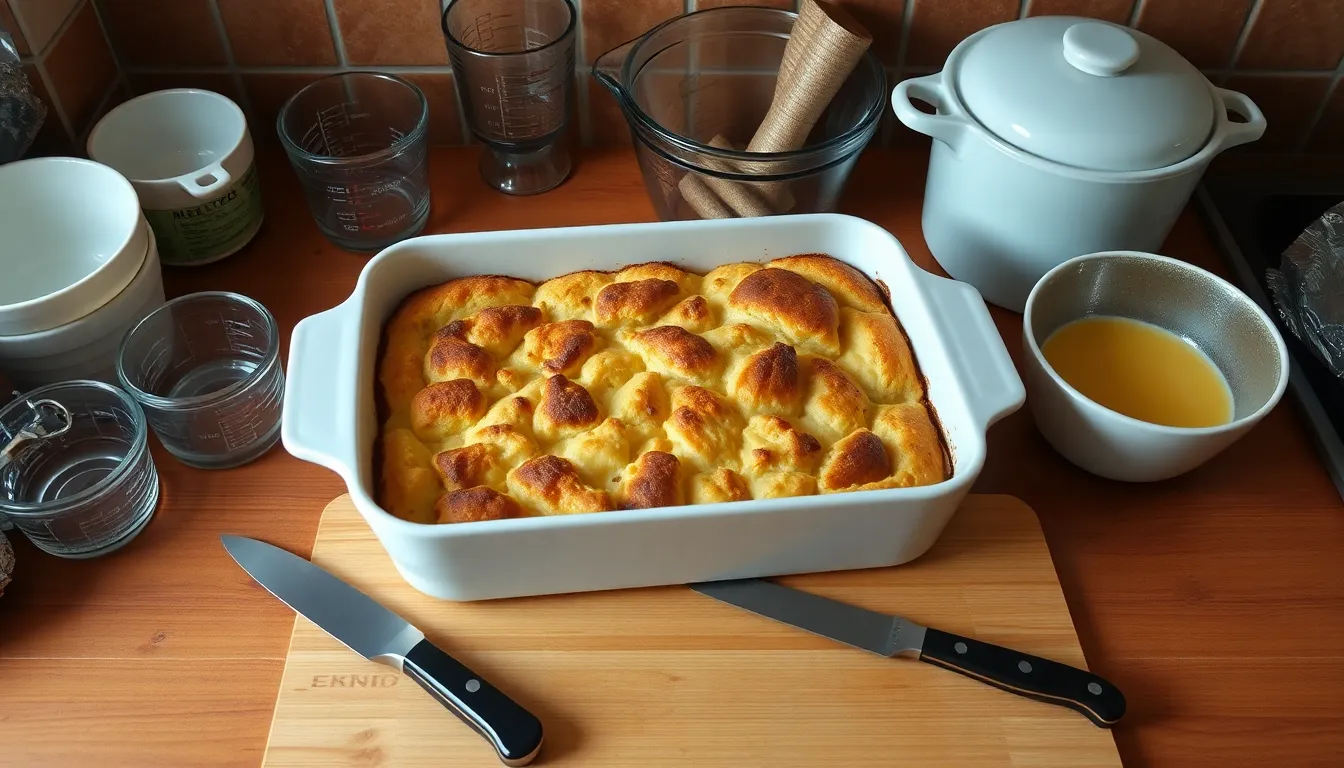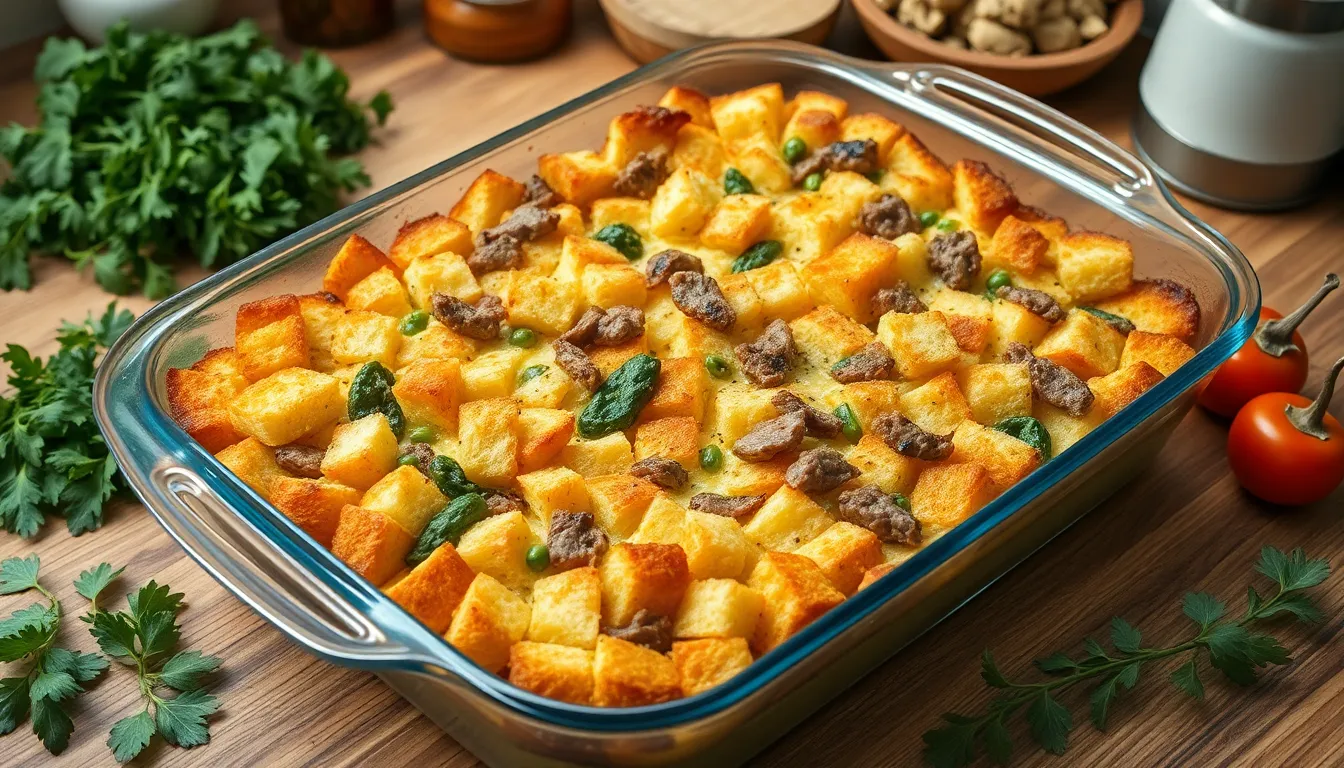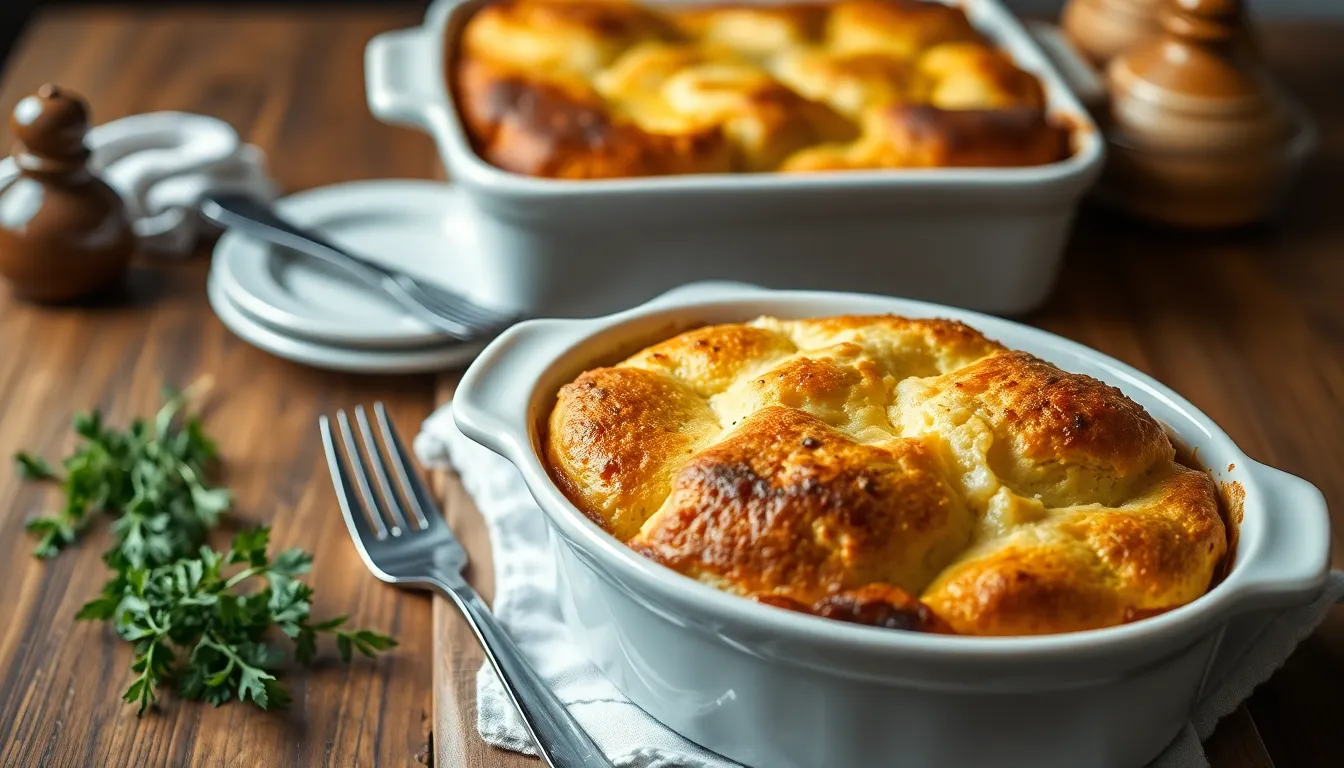We’ve discovered the perfect way to transform day-old bread into something absolutely spectacular. Savory bread pudding takes the beloved comfort food concept and gives it a sophisticated twist that’ll have your guests asking for the recipe. This isn’t your grandmother’s sweet dessert version – we’re talking about a rich, custardy masterpiece loaded with herbs, cheese, and vegetables that works beautifully as a side dish or main course.
What makes this dish so irresistible is its incredible versatility and forgiving nature. You can customize it with whatever ingredients you have on hand, from leftover roasted vegetables to different cheese combinations. The magic happens when stale bread soaks up a seasoned egg mixture, creating layers of flavor that develop into golden, pillowy perfection.
We’ll show you how to create this restaurant-quality dish that’s surprisingly simple to master. Once you try our foolproof technique, you’ll never look at leftover bread the same way again.
Ingredients
We’ve carefully selected each ingredient to build layers of flavor and texture in our savory bread pudding. These components work together to transform day-old bread into a restaurant-quality dish.
Bread and Base
- 8-10 cups day-old bread, cut into 1-inch cubes (French bread, brioche, or sourdough work best)
- 2 tablespoons butter, for greasing the baking dish
- 1 tablespoon olive oil
Vegetables and Aromatics
- 1 large onion, diced
- 3 cloves garlic, minced
- 1 bell pepper, chopped
- 2 cups fresh spinach, roughly chopped
- 1 cup mushrooms, sliced
- 2 tablespoons fresh herbs (thyme, rosemary, or sage)
- 1 teaspoon salt
- 1/2 teaspoon black pepper
Cheese and Protein
- 1 1/2 cups sharp cheddar cheese, grated
- 1/2 cup Parmesan cheese, grated
- 1 cup cooked bacon, crumbled (or ham, sausage, or leftover roasted chicken)
Custard Mixture
- 6 large eggs
- 2 1/2 cups whole milk
- 1/2 cup heavy cream
- 1 teaspoon Dijon mustard
- 1/4 teaspoon nutmeg
- 1/2 teaspoon paprika
Equipment Needed

Before we transform our day-old bread into a magnificent savory bread pudding, let’s gather the essential kitchen tools that will ensure perfect results every time.
Large Baking Dish – We recommend using a 9×13-inch casserole dish or a 12-inch cast iron skillet for this recipe. The generous size allows our bread mixture to cook evenly while developing that coveted golden-brown top layer.
Reliable Oven – Preheating our oven to 350°F (175°C) creates the optimal environment for even baking throughout the entire dish. This temperature ensures our custard sets properly without overcooking the edges.
Mixing Bowls – We’ll need at least two medium-sized mixing bowls to combine our eggs, dairy ingredients, and seasonings separately from our bread and vegetables. Having dedicated bowls prevents cross-contamination and makes assembly smoother.
Sharp Knife and Cutting Board – These tools are crucial for chopping our bread into uniform cubes, dicing vegetables, and preparing any proteins we’re adding to our savory bread pudding.
Measuring Cups and Spoons – Accurate measurements ensure our custard base has the perfect consistency and our seasonings create balanced flavor throughout the dish.
Aluminum Foil – Keep a sheet handy to tent our bread pudding if the top begins browning too quickly during the baking process. This simple technique prevents burning while allowing the interior to finish cooking properly.
Large Spoon or Spatula – We’ll use this for gently folding ingredients together and spreading our mixture evenly in the baking dish before it goes into the oven.
Instructions

Let’s transform our day-old bread into a restaurant-quality savory bread pudding by following these essential steps. We’ll build layers of flavor while ensuring the perfect texture through proper preparation techniques.
Prep the Bread
Cut our day-old bread into 1-inch cubes using a sharp knife. Spread the bread cubes evenly on a large baking sheet to air-dry for 30 minutes if the bread isn’t sufficiently stale. Toss the cubed bread with 2 tablespoons of melted butter and 1 tablespoon of olive oil in a large mixing bowl. This coating prevents the bread from becoming soggy while adding richness to every bite. Transfer the seasoned bread cubes to our greased 9×13-inch baking dish and set aside.
Prepare the Vegetables
Heat 2 tablespoons of olive oil in a large skillet over medium heat. Add the diced onion and cook for 3-4 minutes until softened and translucent. Stir in the minced garlic and cook for another 30 seconds until fragrant. Add the bell pepper and mushrooms to the skillet and sauté for 5-6 minutes until the vegetables release their moisture and become tender. Fold in the fresh spinach and cook just until wilted, about 1-2 minutes. Season the vegetable mixture with salt, pepper, and fresh herbs before removing from heat.
Make the Custard
Whisk the eggs thoroughly in a large mixing bowl until well combined. Gradually add the whole milk and heavy cream while continuing to whisk. Stir in the Dijon mustard, nutmeg, and paprika until the mixture is smooth and uniform. Season generously with salt and freshly ground black pepper. Add half of our shredded cheddar cheese to the custard mixture and whisk until evenly distributed. Taste and adjust seasoning as needed.
Assemble the Bread Pudding
Layer half of our prepared vegetables over the bread cubes in the baking dish. Sprinkle any protein additions like cooked bacon or leftover chicken evenly throughout. Add the remaining vegetables as the top layer. Pour the custard mixture slowly over the entire assembly, ensuring every piece of bread gets saturated. Gently press down on the bread with a large spoon to help absorption. Let the mixture rest for 15-20 minutes to allow the bread to fully absorb the custard. Top with the remaining cheddar cheese and all of the Parmesan cheese.
Bake the Pudding
Preheat our oven to 350°F (175°C) while the bread pudding rests. Cover the dish tightly with aluminum foil and bake for 25 minutes. Remove the foil and continue baking for 20-25 minutes until the top turns golden brown and the center feels firm when gently pressed. Insert a knife into the center of the pudding to check doneness; it should come out mostly clean with just a few moist crumbs. Allow the bread pudding to cool for 10 minutes before serving to let the custard set properly.
Directions for Serving

Our savory bread pudding serves beautifully as either a main course or side dish depending on your meal planning needs. We recommend serving it immediately after the center feels firm to the touch and the top achieves that perfect golden-brown color.
Temperature and Timing
| Serving Temperature | Rest Time | Portion Size |
|---|---|---|
| 160°F internal temp | 10-15 minutes | 6-8 servings as main dish |
| Warm to hot | 5 minutes minimum | 10-12 servings as side dish |
Main Course Presentation
We love serving generous squares directly from our cast iron skillet or casserole dish. Cut the pudding into 6 to 8 equal portions using a sharp knife. The custard should hold its shape while remaining creamy throughout. Pair it with a crisp green salad or roasted vegetables for a complete meal.
Side Dish Options
When serving as a side dish we cut smaller portions that complement roasted meats or grilled chicken. The rich flavors work especially well alongside simple proteins that won’t compete with the bread pudding’s complex taste profile.
Make Ahead Convenience
Our savory bread pudding excels as a make ahead option for entertaining or meal prep. We can assemble the entire dish up to 24 hours before baking and store it covered in the refrigerator. This resting time actually improves the flavors as the bread absorbs more of the seasoned custard.
Customization at Serving
We encourage customizing individual portions with fresh garnishes. Chopped fresh herbs like parsley or chives add brightness. A dollop of sour cream or Greek yogurt provides tangy contrast. Hot sauce or grainy mustard work well for those who enjoy extra flavor punch.
Storage and Reheating
Leftover portions keep well in the refrigerator for up to 4 days. We reheat individual servings in the microwave for 1 to 2 minutes or warm larger portions in a 325°F oven until heated through.
Make-Ahead Instructions

We love how savory bread pudding transforms from a day-of project into an effortless make-ahead masterpiece. This dish actually improves when prepared in advance since the bread has more time to absorb all those rich custard flavors.
Assembly Phase
Start by assembling all your ingredients directly in your greased 9×13-inch baking dish. Layer the buttered bread cubes first then add your sautéed vegetables cheese and any cooked meat you’re including. We recommend preparing this mixture up to 24 hours before baking for maximum convenience and flavor development.
Soaking Process
Pour your prepared custard mixture over the assembled ingredients ensuring every bread cube gets coated. The soaking step is crucial for achieving that perfect creamy texture we’re after. Allow the mixture to rest in the refrigerator for at least 30 minutes though overnight soaking produces the best results. This extended time lets the bread fully absorb the custard creating an evenly cooked dish with incredible moisture.
Temperature Guidelines
| Storage Method | Time Frame | Temperature |
|---|---|---|
| Refrigerator Assembly | Up to 24 hours | 35-40°F |
| Room Temperature Rest | 15-20 minutes | Before baking |
| Baking Temperature | 40-60 minutes | 350°F (175°C) |
Baking from Cold
When you’re ready to bake let the dish sit at room temperature for 15 to 20 minutes if it’s coming straight from the refrigerator. This brief warming period ensures even cooking throughout. Bake at 350°F for 40 to 60 minutes until the center is set and the top develops a beautiful golden brown color.
Freezing Options
Uncooked assembled bread pudding freezes beautifully for future meals. Wrap the entire dish tightly and freeze for up to three months. Thaw overnight in the refrigerator before baking as directed. Alternatively you can freeze individual baked portions for quick weeknight dinners that reheat perfectly in the oven or microwave.
Storage Best Practices
Keep your assembled dish covered tightly in the refrigerator to prevent the top from drying out. We use plastic wrap followed by aluminum foil for the best seal. This method maintains moisture while preventing any refrigerator odors from affecting your carefully crafted flavors.
Storage and Reheating Tips

Our savory bread pudding stores beautifully and reheats like a dream. We recommend following these guidelines to maintain the dish’s creamy texture and rich flavors.
Refrigeration Storage
Fresh bread pudding keeps well in the refrigerator for up to 4 days when stored properly. We suggest covering the baking dish tightly with plastic wrap or transferring portions to airtight containers. The custard base maintains its consistency throughout this storage period.
| Storage Method | Duration | Temperature |
|---|---|---|
| Refrigerated (covered) | 2-4 days | 35-40°F |
| Frozen (wrapped) | 2-3 months | 0°F |
Freezing for Long Term Storage
For extended storage we wrap the entire casserole tightly in plastic wrap followed by aluminum foil. This double wrapping method prevents freezer burn and maintains moisture. Our frozen bread pudding stays fresh for up to 3 months when properly wrapped.
Reheating Methods
The oven method produces the best results for reheating our bread pudding. We preheat the oven to 325°F and cover the dish with foil to prevent drying. Most portions reheat thoroughly within 15-20 minutes depending on size.
For extra crispiness we remove the foil during the last 5 minutes of reheating. Some home cooks prefer running the dish under the broiler briefly after reheating to achieve a golden crispy top.
Defrosting Frozen Portions
Frozen bread pudding requires overnight thawing in the refrigerator before reheating. We never recommend thawing at room temperature as this can compromise food safety. Once thawed the reheating process follows the same oven method described above.
Assembly Rest Period
When making bread pudding ahead we always allow the assembled dish to rest for 30 minutes to 1 hour before baking. This resting period allows the bread to fully absorb the egg mixture resulting in better texture and flavor distribution throughout the dish.
Recipe Variations

Our savory bread pudding serves as a blank canvas for countless flavor combinations. We can easily adapt this base recipe to accommodate different dietary preferences and seasonal ingredients.
Vegetarian Options
We love creating plant-based versions that pack incredible flavor without any meat. Mushroom and leek combinations work beautifully, with chanterelle or cremini mushrooms providing an earthy richness that pairs perfectly with sautéed leeks and Gruyère cheese.
Fresh greens transform our bread pudding into a nutritious powerhouse. We often fold in baby spinach or kale along with roasted seasonal vegetables for added texture and color. These leafy additions wilt perfectly during baking while maintaining their nutritional value.
Cheese selection becomes crucial in vegetarian versions since we rely on it for protein and bold flavors. Blue cheese creates an intense, tangy profile while Parmigiano adds nutty depth. We recommend using these stronger cheeses more sparingly to balance their powerful flavors.
Meat Lovers Version
Bacon remains our top choice for adding smoky richness to savory bread pudding. We crisp the bacon first, then use the rendered fat to sauté our vegetables before crumbling the meat back into the mixture. This technique infuses every layer with that irresistible bacon flavor.
Sausage versions offer hearty satisfaction, especially when we combine Italian sausage with broccoli, fresh thyme, and sharp cheddar. The sausage should be fully cooked and drained before incorporating to prevent excess grease in the final dish.
Ham provides a milder meat option that works especially well for brunch presentations. We layer thin ham slices between the bread and vegetables, creating distinct flavor pockets throughout each serving.
Seasonal Variations
Spring ingredients bring fresh, bright flavors to our bread pudding. Asparagus spears and tender leeks pair beautifully with fresh herbs like chives and parsley. We blanch the asparagus briefly to maintain its vibrant color and crisp texture.
Summer variations showcase peak produce like zucchini, ripe tomatoes, and fragrant basil. These ingredients release more moisture during baking, so we recommend salting and draining the zucchini beforehand to prevent a soggy texture.
Fall and winter versions embrace heartier vegetables that complement the dish’s warming nature. Roasted butternut squash adds natural sweetness while mushrooms and kale provide earthy depth. We roast these vegetables separately before folding them into our bread mixture to concentrate their flavors.
Conclusion
We’ve shown you how transforming leftover bread into savory bread pudding can elevate your kitchen game while reducing food waste. This versatile dish adapts to whatever ingredients you have on hand making it perfect for busy weeknights or special occasions.
The beauty of savory bread pudding lies in its flexibility and make-ahead convenience. Whether you’re feeding a crowd or meal prepping for the week this recipe delivers consistent restaurant-quality results every time.
Don’t let another loaf of day-old bread go to waste. Try this technique and discover how simple ingredients can create something truly spectacular for your table.
Frequently Asked Questions
What type of bread works best for savory bread pudding?
Day-old French bread, brioche, or sourdough work excellently for savory bread pudding. The key is using stale bread that’s 1-2 days old, as it absorbs the custard mixture better without becoming mushy. Cut the bread into 1-inch cubes and let them air-dry for best results.
Can I make savory bread pudding ahead of time?
Yes, savory bread pudding is perfect for make-ahead preparation. You can assemble the entire dish up to 24 hours in advance and refrigerate it. The flavors actually improve overnight as the bread fully absorbs the custard mixture, making it even more flavorful when baked.
How long does savory bread pudding last in the refrigerator?
Properly stored savory bread pudding will keep in the refrigerator for up to 4 days. Cover it tightly with plastic wrap or store in an airtight container. For longer storage, you can freeze it for up to 3 months when properly wrapped.
What vegetables can I add to savory bread pudding?
You can customize your savory bread pudding with various vegetables like onions, garlic, bell peppers, mushrooms, spinach, leeks, or seasonal produce. Sauté harder vegetables first to ensure they cook properly, while leafy greens can be added directly to the mixture.
How do I know when savory bread pudding is done baking?
The savory bread pudding is done when the center is set and no longer jiggly, the top is golden brown, and a knife inserted in the center comes out mostly clean. This typically takes 45-55 minutes at 350°F, covered with foil for the first 30 minutes.
Can I freeze savory bread pudding?
Yes, you can freeze savory bread pudding either before or after baking. Wrap it tightly in plastic wrap and aluminum foil. Unbaked versions can be frozen for up to 3 months, while baked portions should be consumed within 2-3 months for best quality.
What’s the best way to reheat leftover savory bread pudding?
Reheat savory bread pudding in a 325°F oven, covered with foil to prevent drying out. Heat for 15-20 minutes for individual portions or 25-30 minutes for larger sections. You can also microwave individual servings for 1-2 minutes for quick reheating.
How much savory bread pudding should I serve per person?
For a main course, plan for about 1 cup or a 4×4-inch square per person. If serving as a side dish, a smaller 3×3-inch portion or ¾ cup is sufficient. The rich, filling nature of this dish means portions don’t need to be overly large.







